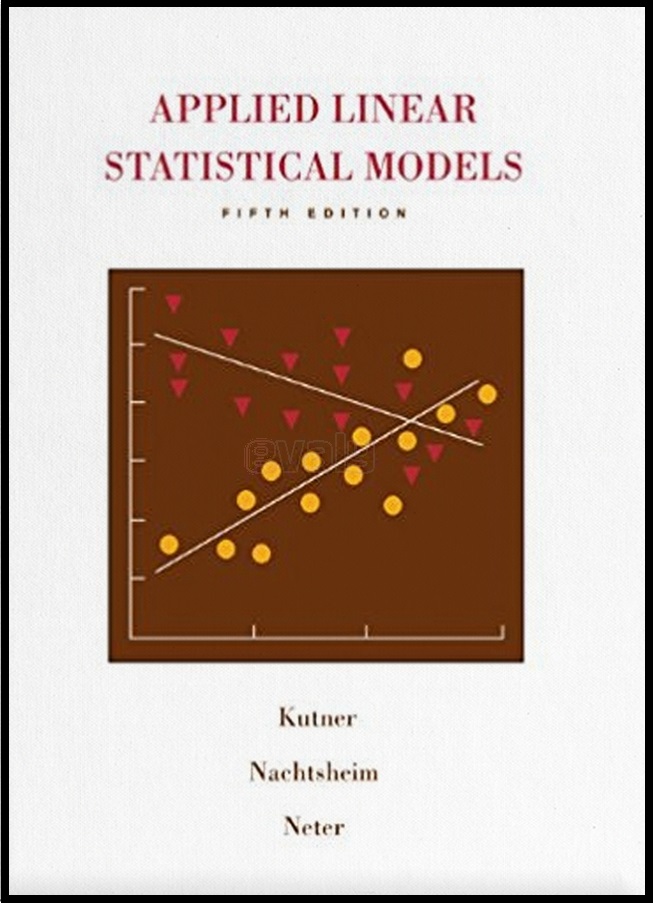Applied Linear Statistical Models, Part 5 - Class Notes
From Applied Linear Statistical Models, by Michael Kutner, Christopher Nachtsheim, John Neter, and William Li (McGraw Hill, 2005)

Copies of the classnotes are on the internet in PDF format as given below. The notes and supplements may contain hyperlinks to posted webpages; the links appear in red fonts. The "Proofs of Theorems" files were prepared in Beamer. The "Printout of Proofs" are printable PDF files of the Beamer slides without the pauses. These notes have not been classroom tested and may have typographical errors.
"Applied Linear Statistical Models" is not a formal class at ETSU, but the material here might overlap some with the Statistical Methods sequence (STAT 5710 and 5720). The book and these notes are broken into six parts. Links to the parts are given on my main Applied Linear Statistical Models webpage.
PART FIVE. MULTI-FACTOR STUDIES
Chapter 19. Two-Factor Studies with Equal Sample Sizes.
- 19.1. Two-Factor Observational and Experimental Studies.
- 19.2. Meaning of ANOVA Model Elements.
- 19.3. Model I (Fixed Factor Levels) for Two-Factor Studies.
- 19.4. Analysis of Variance.
- 19.5. Evaluation of Appropriateness of ANOVA Model.
- 19.6. F Tests.
- 19.7. Strategy for Analysis.
- 19.8. Analysis of Factor Effects when Factors Do Not Interact.
- 19.9. Analysis of Factor Effects when Interactions Are Important.
- 19.10. Pooling Sums of Squares in Two-Factor Analysis of Variance.
- 19.11. Planning of Sample Sizes for Two-Factor Studies.
- Study Guide 19.
Chapter 20. Two-Factor Studies - One Case per Treatment.
- 20.1. No-Interaction Model.
- 20.2. Tukey Test for Additivity.
- Study Guide 20.
Chapter 21. Randomized Complete Block Designs.
- 21.1. Elements of Randomized Complete Block Designs.
- 21.2. Model for Randomized Complete Block Designs.
- 21.3. Analysis of Variance and Tests.
- 21.4. Evaluation of Appropriateness of Randomized Complete Block Model.
- 21.5. Analysis of Treatment Effects.
- 21.6. Use of More than One Blocking Variable.
- 21.7. Use of More than One Replicate in Each Block.
- 21.8. Factorial Treatments.
- 21.9. Planning Randomized Complete Block Experiments.
- Study Guide 21.
Chapter 22. Analysis of Covariance.
- 22.1. Basic Ideas.
- 22.2. Single-Factor Covariance Model.
- 22.3. Example of Single-Factor Covariance Analysis.
- 22.4. Two-Factor Covariance Analysis.
- 22.5. Additional Considerations for the Use of Covariance Analysis.
- Study Guide 22.
Chapter 23. Two-Factor Studies with Unequal Sample Sizes.
- 23.1. Unequal Sample Sizes.
- 23.2. Use of Regression Approach for Testing Factor Effects when Sample Sizes Are Unequal.
- 23.3. Inferences about Factor Effects when Sample Sizes Are Unequal.
- 23.4. Empty Cells in Two-Factor Studies.
- 23.5. ANOVA Inferences when Treatment Means Are of Unequal Importance.
- 23.6. Statistical Computing Packages.
- Study Guide 23.
Chapter 24. Multi-Factor Studies.
- 24.1. ANOVA Model for Three-Factor Studies.
- 24.2. Interpretation of Interactions in Three-Factor Studies.
- 24.3. Fitting of ANOVA Model.
- 24.4. Analysis of Variance.
- 24.5. Analysis of Factor Effects.
- 24.6. Unequal Sample Sizes in Multi-Factor Studies.
- 24.7. Planning of Sample Sizes.
- Study Guide 24.
Chapter 25. Random and Mixed Effects Models.
- 25.1. Single-Factor Studies - ANOVA Model II.
- 25.2. Two-Factor Studies - ANOVA Models II and III.
- 25.3. Two-Factor Studies - ANOVA Tests for Models II and III.
- 25.4. Two-Factor Studies - Estimation of Factor Effects for Models II and III.
- 25.5. Randomized Compete Block Design: Random Block Effects.
- 25.6. Three-Factor Studies - ANOVA Models II and III.
- 25.7. ANOVA Models II and III with Unequal Sample Sizes.
- Study Guide 25.
Return to Bob Gardner's home page

